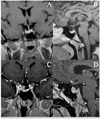Delayed Diagnosis of Cushing's Disease in a Pediatric Patient due to Apparent Remission from Spontaneous Apoplexy
- PMID: 28848696
- PMCID: PMC5571867
- DOI: 10.1016/j.jecr.2016.09.001
Delayed Diagnosis of Cushing's Disease in a Pediatric Patient due to Apparent Remission from Spontaneous Apoplexy
Abstract
We report here a pediatric patient whose Cushing's Disease was diagnosed late because of her cyclical presentation, presumably due to subclinical pituitary apoplexy. Starting at age 8, she presented with observable signs of Cushing's but was not clinically assessed for Cushing's Syndrome until the age of 15. Initial tests at age 15 were consistent with Cushing's Disease, however, the patient presented with spontaneous remission of hypercortisolemia just a few short months later. Her cushingoid features never subsided, and at age 17, her MRI showed a partially empty sella; this finding of an empty sella contributed evidence to our suspicion of asymptomatic apoplexy, especially since the patient never reported an episode of acute headache. Pituitary apoplexy in corticotroph adenomas is very uncommon, but even more rare in microadenomas, making this case very unusual. Lost to follow-up, she was not reevaluated for Cushing's Disease until age 25, and her laboratory tests were consistent with an adrenocorticotrophic-dependent pituitary tumor; Pituitary magnetic resonance imaging revealed a 9 mm X 6 mm X 8 mm mass projecting on the superior aspect of pituitary and abutting the wall of the right cavernous sinus. The patient had a transsphenoidal surgery to remove the microadenoma and is planned to undergo radiation therapy. To the best of our knowledge, this is the first report of subclinical apoplexy of a microadenoma in a pediatric patient with Cushing's Disease. It brings to light the importance of long term follow up for pediatric patients presenting with clinical symptoms of Cushing's Syndrome.
Keywords: Cushing’s Syndrome; Hypercortisolemia; adolescent; cyclical Cushing’s; pituitary tumor.
Figures



Similar articles
-
Spontaneous Cushing's Disease Remission Induced by Pituitary Apoplexy.Cureus. 2024 Jul 10;16(7):e64231. doi: 10.7759/cureus.64231. eCollection 2024 Jul. Cureus. 2024. PMID: 39130944 Free PMC article.
-
Pituitary apoplexy induced by corticotrophin-releasing hormone in a patient with Cushing's disease.Clin Endocrinol (Oxf). 2003 May;58(5):545-9. doi: 10.1046/j.1365-2265.2003.01720.x. Clin Endocrinol (Oxf). 2003. PMID: 12699434
-
Asymptomatic pituitary apoplexy induced by corticotropin-releasing hormone in a 14 year-old girl with Cushing's disease.J Pediatr Endocrinol Metab. 2021 Apr 5;34(6):799-803. doi: 10.1515/jpem-2020-0499. Print 2021 Jun 25. J Pediatr Endocrinol Metab. 2021. PMID: 33818042
-
Spontaneous remission of Cushing's disease: A systematic review.Ann Endocrinol (Paris). 2021 Dec;82(6):613-621. doi: 10.1016/j.ando.2021.10.002. Epub 2021 Oct 21. Ann Endocrinol (Paris). 2021. PMID: 34687655
-
Resolution of Cushing's disease followed by secondary adrenal insufficiency after anticoagulant-associated pituitary hemorrhage: report of a case and review of the literature.Endocr Pract. 2003 Mar-Apr;9(2):147-51. doi: 10.4158/EP.9.2.147. Endocr Pract. 2003. PMID: 12917078 Review.
References
-
- Oldfield EH, Merrill MJ. Apoplexy of pituitary adenomas: the perfect storm. Journal of neurosurgery. 2015;122(6):1444–1449. - PubMed
-
- Mohr G, Hardy J. Hemorrhage, necrosis, and apoplexy in pituitary adenomas. Surgical neurology. 1982;18(3):181–189. - PubMed
-
- Sibal L, Ball SG, Connolly V, et al. Pituitary apoplexy: a review of clinical presentation, management and outcome in 45 cases. Pituitary. 2004;7(3):157–163. - PubMed
-
- Jankowski PP, Crawford JR, Khanna P, et al. Pituitary tumor apoplexy in adolescents. World neurosurgery. 2015;83(4):644–651. - PubMed
-
- Alarifi A, Alzahrani AS, Salam SA, et al. Repeated remissions of Cushing's disease due to recurrent infarctions of an ACTH-producing pituitary macroadenoma. Pituitary. 2005;8(2):81–87. - PubMed
Grants and funding
LinkOut - more resources
Full Text Sources
Other Literature Sources
